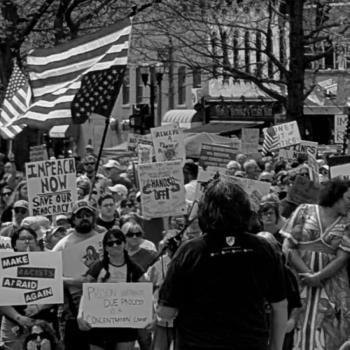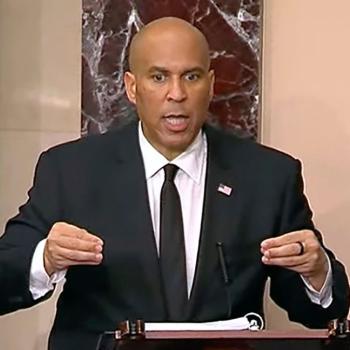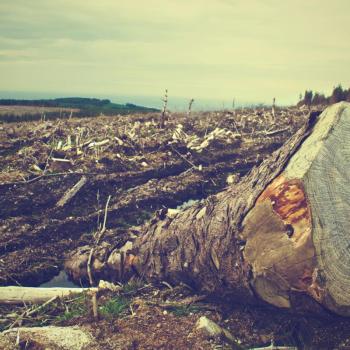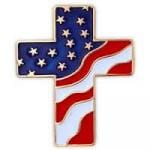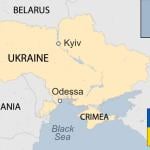The 2019 high school marching band season in Kentucky has come to an end and the Lafayette High School Marching Band from Lexington has once again earned first place in the 5A category at the Kentucky Music Educators Association (KMEA) state marching band competition. They performed their show, Seeking Refuge, at Western Kentucky University on October 26, 2019. This is the third year in a row of winning the competition and marks the band’s 21st state championship. They also won the Bands of America Regional Championship in Tennessee earlier this month.

Lafayette’s show, “Seeking Refuge,” was notable not just for the amazing performance by the students, but because of the provocative theme and music.
The Lafayette Marching Band performed a show that some might say made a political statement. But, more importantly, it was prophetic, because it presented not just a critique of the world as it is but lifted up a vision of what it can and should be. Not only that, but the show included musical “quotes” from powerful hymns that added a layer of sacredness that I have not ever experienced in watching a marching band show before.
[View the video here.]
My daughter is in the Lafayette Marching Band, and my husband is one of the instructors for the drum line. That being the case, I have attended countless marching band competitions and watched close to 100 shows in my life, if not more.
I have never seen the kind of show like Seeking Refuge that Lafayette put together for their 2019 season.*
The show begins with the band members on the outer edges of the field and the color guard in the center. In their black field caps, uniforms, and visors, the musicians look like soldiers who are moving in on the children – the color guard who are dressed in white outfits that symbolize the innocence of youth.

The children are playing with each other in the center of the field until the soldiers rush in, hitting them, throwing them to the ground, and attacking them. During this opening, an eerie Gregorian chant and music from a flute ensemble float over the scene, creating a surreal and ominous effect.
The whole band then surrounds the children, their instruments pointed like weapons.
The set pieces are huge curved spikes jutting into the air. They are moved into a “wall” in one section of the field as the battery hammers out a militaristic rhythm that electrifies the troops in a unified line. The dramatic first movement ends with a group of soldiers chasing a child across the field to the wall where they surround her and point their “guns.” She falls to the ground.
Every time I watch this, I am reminded of children at the southern border of the United States. I am reminded of children separated from their families, locked in cages. I am reminded of Kurdish children screaming in agony, their bodies burned by chemical weapons launched by the Turkish army. I am reminded of Iraqi children, Vietnamese children, African children, attacked by soldiers. I think of children all over the world who have been caught in the cross-fire or deliberately attacked by men in uniforms with weapons.
In just under three minutes, the band captured this horrific reality with dramatic and perfectly-executed precision.
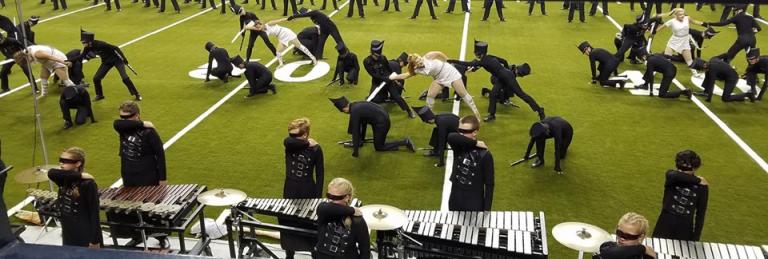
The second movement is almost like a ballet. The soldiers sit in suspended animation while a flute solo accompanies the dance of the children in front of the wall. It is in this movement where we hear the first hymn. The first two stanzas of Martin Luther’s “A Mighty Fortress is Our God” rises from the front ensemble of xylophones, vibraphones and marimbas like an ethereal music box lullaby. As a Lutheran pastor, I recall the words from our hymnal:
A mighty fortress is our God,
a sword and shield victorious;
he breaks the cruel oppressor’s rod
and wins salvation glorious.
When the soldiers finally rise from their positions, their movements are slow and majestic, indicating that perhaps a transformation is beginning.
The final movement begins with an organ solo accompanied by the front ensemble as the children emerge wearing white and gold, another sign that transformation is happening – from fearfulness to fearlessness, even as the soldiers continue their intricate drills across the field.

In this movement the low brass gives us the second hymn– “O God, Our Help in Ages Past.” This 18th century hymn by Isaac Watts contains these lyrics:
O God, our help in ages past,
our hope for years to come,
our shelter from the stormy blast,
and our eternal home.
The use of sacred music in this show invokes the notion of divine intervention as a primary source of justice when those who are vulnerable are seeking refuge. This brings to mind the sanctuary movement of churches advocating for and protecting refugees (including the ELCA that declared itself a “sanctuary denomination”). Or churches serving as hospitals during the Civil War. Or as way stations along the Underground Railroad.
As the movement comes to its climax, the giant spikes are turned into a circular refuge. In other words, the walls of pain are transformed into a sanctuary. Swords become plowshares, instruments of death are changed into protectors of life.
Yet the soldiers move in to surround the refuge. They encircle the sanctuary like a dark, menacing swarm.
But then something happens.
As a rising wall of otherworldly sound fills the stadium, the soldiers remove their caps and place them on the ground as the sanctuary lights up in a glorious transformation. The soldiers turn around to reveal that they are human, they are flesh and blood. Not military automatons, but real people – young women and men whose humanity is finally set free. At the conclusion, the sanctuary door opens to reveal a soldier lifting a child up onto his shoulders and the musicians remove their visors. Their eyes and faces beam. The transformation is complete.
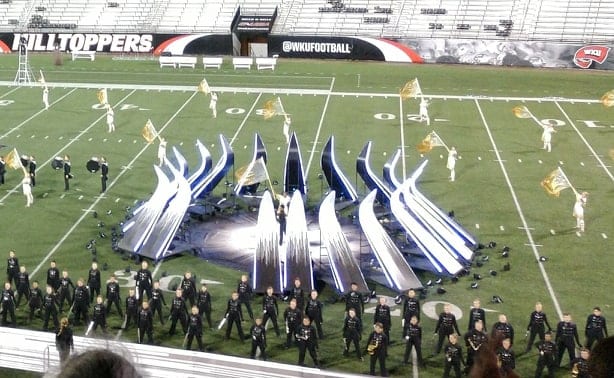
It is a powerfully emotional moment that makes me cry every time I see it, because it reminds me of the vision of Isaiah 11:6:
The wolf shall dwell with the lamb, and the leopard shall lie down with the kid; and the calf and the young lion … together; and a little child shall lead them.
Indeed, a child shall lead us. These high school students have put their heart and soul into a prophetic vision that shows us what it looks like when the soldiers put down their weapons, take off their masks of violence, and become the protectors of children. No longer pawns of war, they are now instruments of peace.
Transformation is possible – from fear to courage, from violence to peace, from hatred to love.
I am grateful to Lafayette Marching Band’s director, Chuck Smith, and his entire staff for putting together a show like this. From the music arranger, to the drill writer, to the assistant directors and instructors, to the parent volunteers, to the students – it takes courage to do what you’ve done in this show. You have shown us how music and a marching band can offer both prophetic critique as well as a hopeful vision of what is possible.
Seeking Refuge is the refuge we seek.
* Disclaimer: To be clear – this is my own interpretation of this marching band’s show and is not representative of the views of the Lafayette High School Marching Band, its director, the school’s principal, or the district’s superintendent. Others may see the show differently. Works of art are always open to different interpretations.

Leah D. Schade is the Assistant Professor of Preaching and Worship at Lexington Theological Seminary in Kentucky. She is the author of Preaching in the Purple Zone: Ministry in the Red-Blue Divide (Rowman & Littlefield, 2019) and Creation-Crisis Preaching: Ecology, Theology, and the Pulpit (Chalice Press, 2015).
Twitter: @LeahSchade
Facebook: https://www.facebook.com/LeahDSchade/
Read also:
Lafayette Marching Band’s “Peace of Mind” Is What We Needed
A New Dawn: Lafayette High School Marching Band Brings Us Home




